Jaltomata quipuscoae Mione & S. Leiva |
southern Peru |
revised March 2021 |
The information on this page may be cited as a communication with professor Thomas Mione, Central Connecticut State University, Biology Department, Copernicus Hall, 1615 Stanley Street, New Britain, CT 06050-4010 USA, and Segundo Leiva G., Universidad Privada Antenor Orrego, Av. América Sur 3145, Casilla postal 1075, Trujillo, Peru |
Link to Jaltomata species having red nectar |
Link to Jaltomata species of southern Peru |
Figure 1. Flowers of Jaltomata quipuscoae. Photo by Victor Quipuscoa, Quipuscoa et al. 3352 |
Figure 2. Flowers of Jaltomata quipuscoae. Photo by Victor Quipuscoa, Quipuscoa et al. 3352 |
Figure 3. Flower of Jaltomata quipuscoae. Three anthers dehsiced while the two on the left remain undehisced. Photo by Victor Quipuscoa |
Figure 4. Red nectar. Photo by Victor Quipuscoa, Quipuscoa et al. 3352 |
Figure 5. Leaf shape variation. Photo by Victor Quipuscoa, Quipuscoa et al. 3352 |
Figure 6. Ripe Fruits, Photo by Victor Quipuscoa, Quipuscoa et al. 3352 |
Figure 7. The habitat at the type locality of this species is being destroyed, trampled by livestock. Note the "6" on the rock: this may be an agricultural plot number.
Photo taken while standing in what was the habitat of this species. Mione et al. 797 & 798, photo by Thomas Mione. |
Figure 8. Stems at ground level, photo by Victor Quipuscoa, Quipuscoa et al. 3352 |
Figure 9. Victor Quipuscoa (foreground) and Segundo Leiva G. (rear). Photo by Thomas Mione taken while facing habitat of species, Mione et al. 797 & 798. |
Figure 10. Standing in remnants of the habitat of this species, Mione et al. 797 & 798, photo by Thomas Mione |
| Figure 11. Anther (undehisced) in ventral view and distal portion of filament. On both sides rulers showing mm are oriented vertically, photo by Thomas Mione after flower had been preserved in 70% ethanol for years, Jaltomata quipuscoae, Mione et al. 797. | Figure 12. Anther (undehisced) in dorsal view, and distal portion of filament. On both sides rulers showing mm are oriented vertically, photo by Thomas Mione after flower had been preserved in 70% ethanol for years, Jaltomata quipuscoae, Mione et al. 797. |
| Figure 13. Stems, flower bud (left) and flower's shape in side view. Stems, peduncles, pedicels and the back (abaxial face) of the calyx are pubescent with gland-tipped uniseriate finger hairs. Photo by Victor Quipuscoa, Quipuscoa et al. 3352. |
|---|
Geographic Distribution: Peru, Department Arequipa. Flowering in January & February in the Andes, and in the lomas habitat flowering in October.
| Province | Locality | altitude | habitat | date | collector |
|---|---|---|---|---|---|
Arequipa |
TYPE SPECIMEN Dist. Yarabamba, Alrededores de los Petroglifos de Sogay, S 16 34 0.7" W 71 25 51.2" |
2625 m |
Ladera arbustiva, rocosa |
11 Feb 2006 |
V. Quipuscoa S. et al. 3352 (HUSA, herbarium of T. Mione). |
Arequipa |
Dist. Yarabamba, Alrededores de los Petroglifos de Sogay, S 16 33 58.6, W 71 25 40.6 | 2607 m |
Among rocks, habitat being destroyed by spreading cultivation and grazing |
7 Jan 2010 |
T. Mione, S. Leiva G., V. Quipuscoa, L. Yacher 797 (798 seeds only)(HUSA, herbarium of T. Mione) S. Leiva G. et al. 4654 (HAO). |
Caravelí |
Km 586 Panamericana Sur, 6 km north of Atiquipa turnoff on Panamerican Highway | 300 - 860 m |
lomas, westfacing sandy and rocky slopes |
3 Oct 1997 |
M. Weigend & H. Förther 97/701 (M) Footnote 1. |
| 1) I thank Arturo Granda Paucar for taking the time to bring the details of this specimen to my attention in an email received 15 May 2001. Arturo correctly predicted that this would be a new species, and that it would be closely related to J. aspera. |
Morphology
| Character | Description | |
Growability in Connecticut, USA |
easy to grow in a greenhouse |
|
How long does it take from flower to ripe fruit? |
||
Flowers Closing For The Night? |
No | |
Self-Compatible? |
yes |
Although self-compatible, flowers are not autogamous: pollination by an external vector is required for fruits to be set. |
Seed Germination |
Seeds with partial seedcoat removal immediately prior were treated with 300 ppm gibberellic acid (GA) overnight from 4 to 5 November 2016, and were planted on the surface of potting mix on 5 November. A heat mat warmed the cups 24/7. Seeds showed their first above-ground signs of germination on 10 November 2016. The duration of storage may affect germination; the seeds I used were sent to me by J. Kostyun from plants she grew from seeds I sent to her years earlier. | Seeds planted by T. M. on 12 March 2010 showed their first above-ground signs of germination on 20 April 2010. J. Kostyun (personal communication, 2014) nicked the seeds with a razor blade and applied a drop of 10mM GA to break dormancy. Seeds did not germinate simultaneously: they started about 1 week after GA treatment and continued to germinate occasionally. |
Chromosome number |
no data | |
| Character | Jaltomata quipuscoae |
Pollen production per flower, ovules per ovary, and the Ratio of Pollen to Ovules. In the following table each row represents one flower taken from a greenhouse-grown plant.
| Pollen | Ovules | P / O | |
| 621,250 | 300 | 2071 | |
| 633,125 | 314 | 2016 | |
| 503,125 | 292 | 1723 | |
| 585,833 | 302 | 1937 | mean |
| 503K - 633K | 292-314 | 1723-2071 | range |
Pollen counts in the table were done by Demir Camdzic while ovule counts were done by T. M. (year 2017).
Two additional pollen counts are probably less accurate because each count was done with a single anther (multiplied by 5); these were done in 2013 by
Emmett P. Varricchio and gave 407,500 - 561,500 grains (n = 2, Mione et al. 797). Ovules per ovary was estimated by doubling the count of one locule. Ovaries were dissected in 70% ethanol so that ovules would float away, a few at a time,when dislodged with a needle. Pollen production was estimated using Anderson and Symon's modification of Lloyd's technique.
| Similar Species: The three species of section Modillonia are herbaceous, have solitary flowers, lack corolla lobules, have a corona (figures 15 & 16 of this page), lack radial staminal-corolla thickenings, have a stigma no wider than top of style (stigma punctiform, not capitate), are endemic to Peru and produce copious red/orange nectar. |
| J. aspera | J. calliantha | J. quipuscoae | |
|---|---|---|---|
| corolla color | greenish-yellow or yellow-green |
green |
purple |
| ring of green maculae at base of corolla | no |
yes |
yes |
| filament color | whitish to pale yellowish |
purple |
purple |
| hairs on base of stamen | pubescent |
glabrous |
nearly glabrous (the hairs that are present are visible only with a microscope and are only on the most proximal part of the filament; these are uniseriate finger hairs) |
| vestiture of upper face of mature leaves | nearly glabrous (photo immediately below) |
pubescent (photo immediately below) |
|
| fruit color | orange (Granda 926), white (Macbride 1962) |
very pale-green |
whitish |
| Elevation | Lomas: 150 - 600 m Andes: 1,600 to 2,550 m |
Andes: 1,380 - 2,100 |
Lomas: 300 - 860 m Andes: 2,607 to 2,625 m |
| geography | Peru, Department Lima |
Peru, Department La Libertad and Department Ancash |
Peru, Department Arequipa |
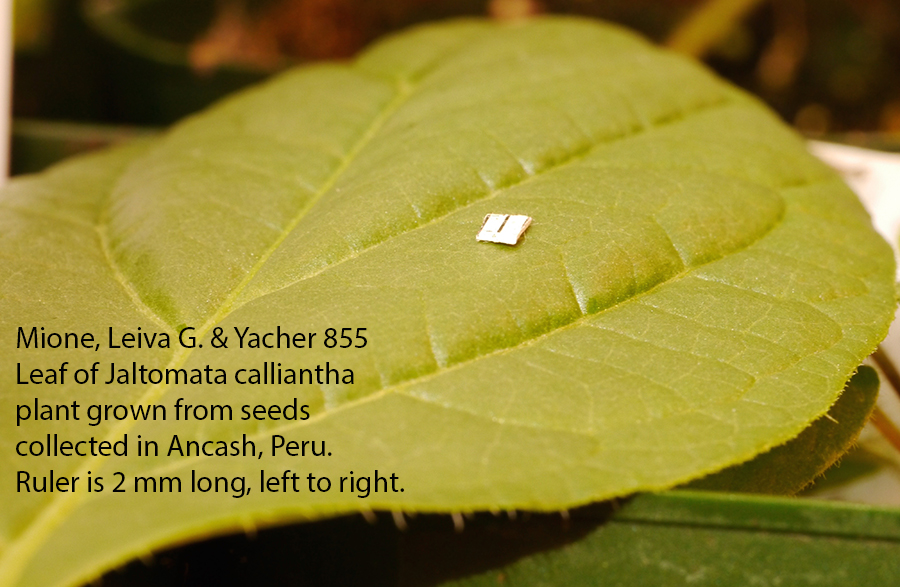 |
|
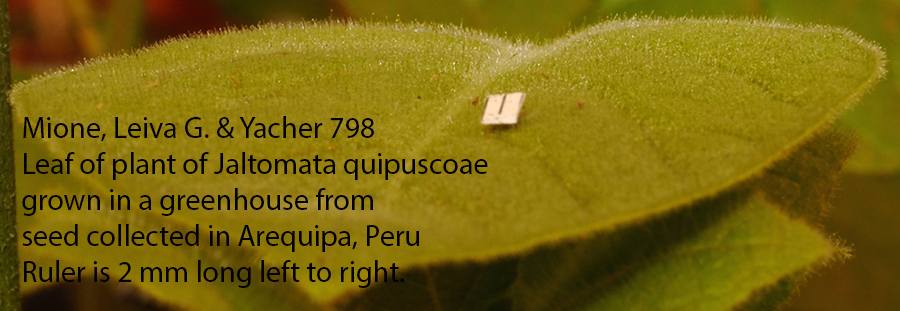 |
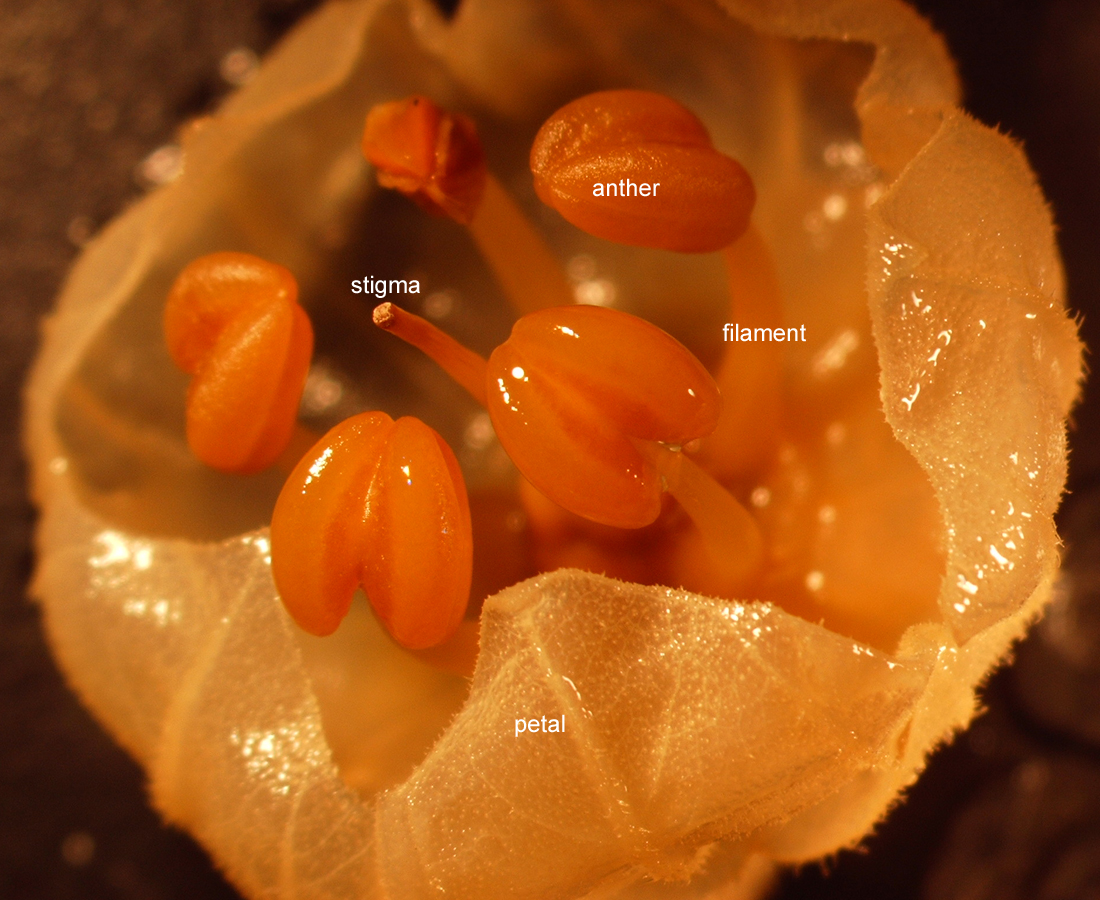 |
| Figure 14. Flower of Jaltomata quipuscoae, Mione 797, photo taken 2012, flower preserved in 70% ethanol prior to photo. |
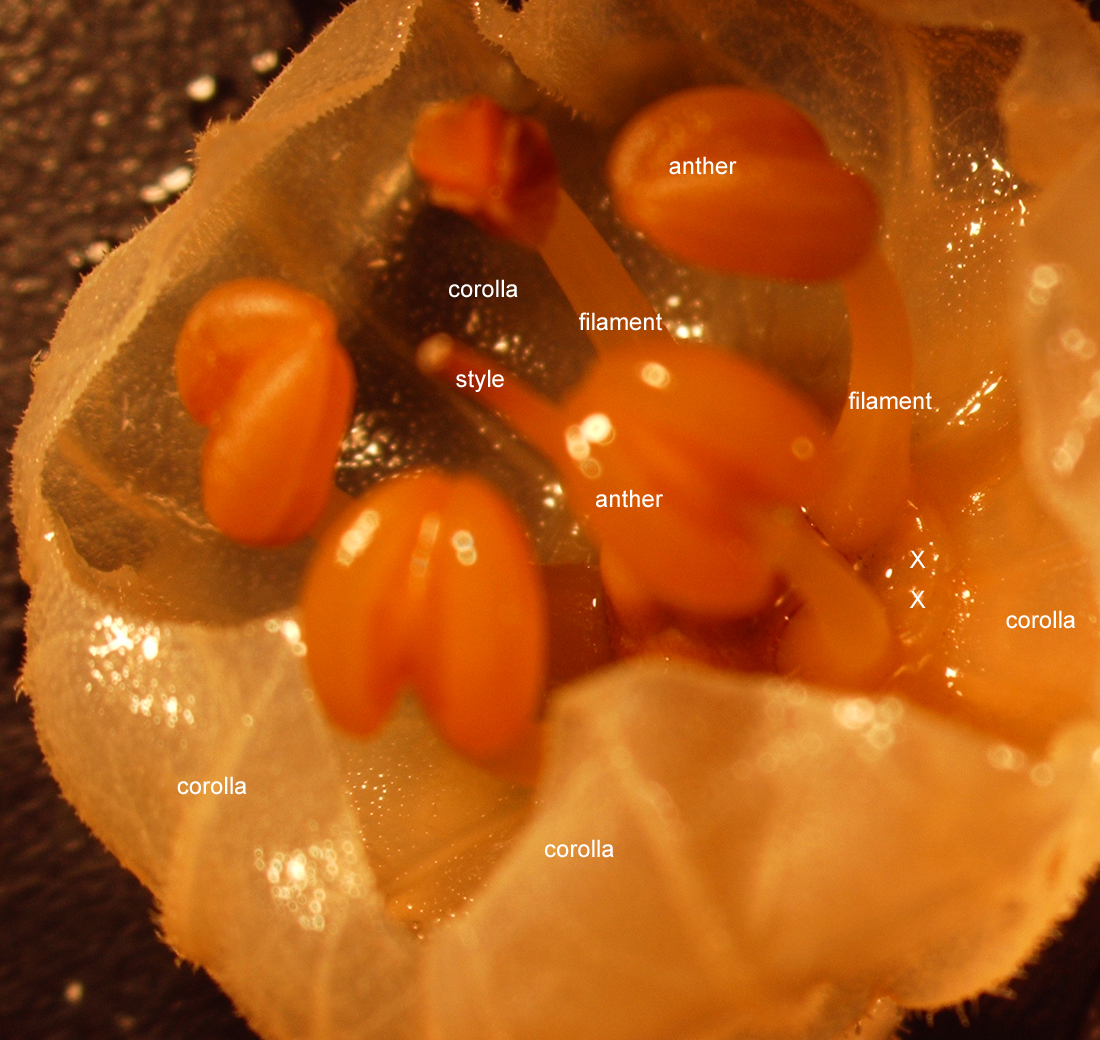 |
| Figure 15. Flower of J. quipuscoae showing corona at X (see right side); the corona is a bowl of tissue on which nectar pools. Only three Jaltomata species have this structure, photo by Thomas Mione, March 2012, flower preserved in 70% ethanol prior to photo. |
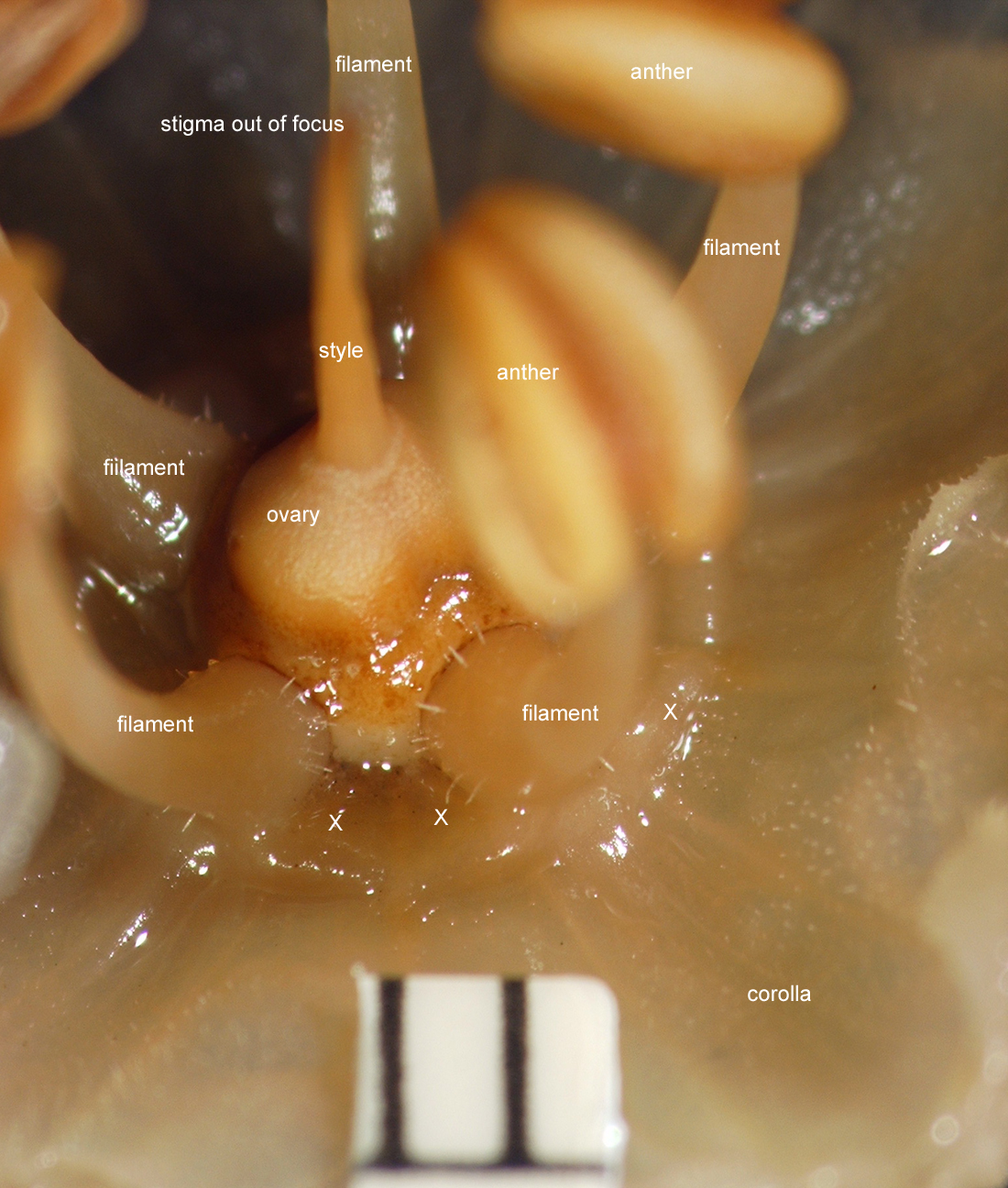 |
| Figure 16. J. quipuscoae. Corona in focus at X. The corona is the bowl of tissue on which nectar pools characteristic of only three Jaltomata species. Distance between two vertical lines in foreground is one mm, Mione et al. 797; flower preserved in 70% ethanol prior to photo. |
Figure 17. Fruit crushed to reveal seeds. This fruit was probably not fully ripe given that the seeds are so light in color. Seeds from ripe fruit are brown. Photo by Victor Quipuscoa, Quipuscoa et al. 3352. |
Figure 18. Leaves, stems and flowers of Jaltomata quipuscoae, photo by Victor Quipuscoa, Quipuscoa et al. 3352 |
Figure 19. Segundo Leiva G. (left) and Victor Quipuscoa S. (right) in the remnants of the habitat of Jaltomata quipuscoae, Mione et al. 797, photo by Thomas Mione |
Figure 20. Leaves, Mione et al. 797, photo by Thomas Mione |
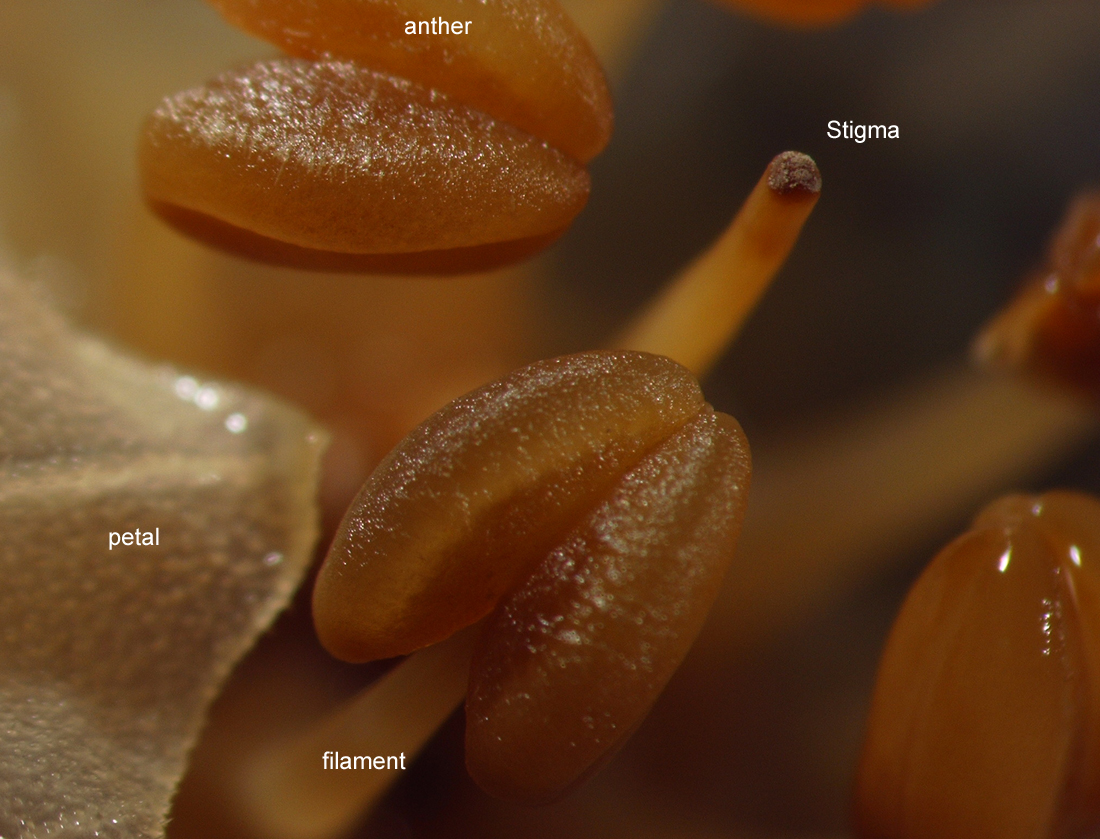 |
| Figure 21, above. Anthers and stigma of Jaltomata quipuscoae. Mione 797, flower preserved in 70% ethanol prior to photo, photo taken 2012. |
| Figure 22. Plant of Jaltomata quipuscoae at base of rock with ruler (about 20 cm long) vertical against rock. The same rock and plant are shown in the following photo. Photo by Thomas Mione, Mione 797. |
| Figure 23. Plant of Jaltomata quipuscoae at base of rock in shadow (ruler about 20 cm long vertically) against rock. The same rock and plant are shown in the previous photo. Photo by Thomas Mione, Mione 797. |
Figure 24. Pollen of Jaltomata quipuscoae Stained with cotton blue in lactophenol
|
Figure 25. Ripe fruit of Jaltomata quipuscoae split open by hand. Plant grown by and photograph by Jamie Kostyun, Mione 798. |
| Figure 26, above. Ripe fruit of Jaltomata quipuscoae. Units horizontally across top are mm. Plant grown by and photograph by Jamie Kostyun, Mione et al.798. |
| Number of weeks from manual pollination (in greenhouse) to ripe fruit: 14 September 2017 to 25 October 2017, one day short of 6 weeks but recorded as six weeks because the fruit had not dropped and I very easily could have harvested it the next day. |